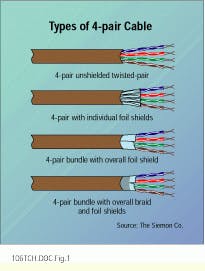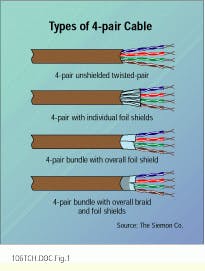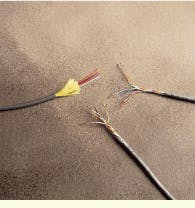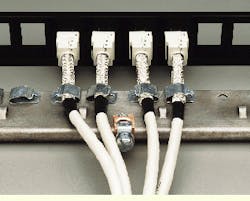Lynn Haber
A number of cable manufacturers offer it, and yet screened twisted-pair (ScTP) cabling has yet to enter the limelight as a preferred structured cabling medium in the United States. While several vendors are quite vocal about the benefits of both ScTP and shielded twisted-pair (STP) cable over unshielded twisted-pair (UTP) cable and optical fiber, others view it as a technology with limited appeal and stiff competition.
A distant cousin to the original IBM Type 1 cable, 150-ohm STP cable was introduced in the early 1980s. The motivations for further development of ScTP technology were better performance compared to UTP without the cost premium and bulkiness of STP.
Available in this country for several years now, ScTP products, according to some manufacturers, continue to suffer from an identity crisis -- one issue being what to call it (foiled, shielded or screened), and the other being its application in premises wiring. With coaxial, UTP and optical-fiber cable already available, some critics contend, why add a fourth type of cabling to the media mix?
STP cable, derived from IBM Type 1 technology, is characterized by a foil wrapper, a braided shield and individually shielded wire pairs. It is defined by the 802.5 token ring standard of the Institute of Electrical and Electronics Engineers (New York, NY) and the commercial building wiring standard for telecommunications published by the Telecommunications Industry Association (TIA -- Arlington, VA), Tia/eia-568a.
STP was designed for data communications and still attracts a small but loyal base of followers, primarily IBM diehards resistant to the more popular UTP. Industry observers agree that STP cable was a terrific design for its time, but with improvements in UTP`s performance, as well as its reduced cost and ease of installation, STP has fallen out of favor in most of the marketplace.
When data communications installations began to skyrocket a few years ago, UTP cable garnered the lion`s share of the market in a short time and continues to hold it. Paul LaFond, director of marketing at Mod-tap (Harvard, MA), reports, for example, that UTP accounts for 80% of his company`s sales. STP, including ScTP, accounts for only 5%, while optical fiber accounts for 15%.
ScTP cable was originally developed in Europe, where wiring standards and emissions requirements are more stringent. ScTP technology includes a cable with the same core as UTP, a foil shield that covers all four wire pairs, a drain wire and a jacket. Jacks and plugs are also screened. ScTP is typically 100-ohm cable and has yet to be fully covered by an Eia/tia standard, despite the fact that standards work has been ongoing for several years (see "Standards Effort Under Way," page 10).
Proponents of ScTP argue that screening the cable protects the data being transmitted from an environment which may contain radio-frequency interference (RFI) and electromagnetic interference (EMI). Likewise, screening helps keep the cable itself from emitting RFI and EMI.
"The initial impetus to look at ScTP was for extra noise protection on higher-speed networks," says Ned Sigmon, associate director of development engineering at AMP Inc. (Harrisburg, PA) and an expert on shielding technologies. More recently, he says, interest in the screened medium is coming from firms in industries such as financial services and banking, where much critical data needs protection from noise. Sigmon also states that hospitals, airports and manufacturing facilities are being drawn to ScTP for similar reasons.
Cabling installers report that ScTP represents a small portion of their business, anywhere from 3% to 10%. They add that interest in ScTP typically comes from companies concerned about noisy environments. "I`ll promote ScTP for applications where there`s a lot of interference, like airports and machine shops," says Sal Almilli, principal at Datasite Inc., an installation company based in Irvine, CA.
UTP cable was designed to carry voice, not high-speed data. The modular jacks and plugs in UTP cabling systems were not designed for high-speed data networks, either. In spite of these facts, however, UTP products have made remarkable progress in the marketplace, with structured cabling systems based on UTP technology routinely deployed for 100-Mbit/sec networks. Asynchronous Transfer Mode (ATM) transmissions at 155 Mbits/sec are now starting to be run over Category 5 UTP as well. More recently, there has been talk of a 1-Gbit/sec version of Ethernet running over UTP cable.
Fundamental limitations
ScTP proponents are quick to jump in with their criticisms of these announcements. "There`s a lot of ignoring of the facts here," says Harry Forbes, director of engineering and product management at ITT Cannon Network Systems & Services (Basingstoke, UK). He contends that UTP has fundamental limitations that affect its ability to reject external noise coupling -- among these limitations being lack of a screen, imperfect connection mechanisms, impedance mismatches and imbalance in the cabling. Coupled with the fact that higher-speed networks increase the overall frequency of transmission, which can lead in turn to EMI and RFI in unshielded media, using UTP cabling with such limitations can result in high-speed networks that are more susceptible to performance problems.
More specifically, ITT Cannon contends that the potential technical impacts upon the end-user of these cabling limitations include inability to run high-speed transmission protocols reliably; inability to meet the requirements of the European Community`s EMC Directive for RF fields; and inability to transmit over extended distances. Economically, there are costs as well: higher administration costs for local area networks (LANs); higher capital outlays for the purchase and replacement of active equipment; and indirect costs associated with system downtime.
AMP`s Sigmon points out that, as the industry looks at the next generation of cabling, there is a general feeling that, for higher performance, network managers will have to look beyond Category 5, the highest level currently specified for UTP cable. He adds that there is a basic problem with UTP that cannot be ignored: Improved performance of unshielded cable depends upon how tightly the pairs are twisted. This electrical balancing mechanism, which is used in lieu of some kind of shielding, has just about reached its limit.
Ed Ellis, vice president of network products at Accu-Tech Corp. (Atlanta, GA), says that when customers begin to feel dissatisfied with Category 5 cabling, they will begin to look at ScTP or fiber. This dissatisfaction, he adds, will result from poor performance, which will manifest itself in such problems as devices dropping off the network intermittently, connection losses and congestion. "We expect UTP will be around for some time, but we also expect interest in ScTP to pick up substantially," Ellis states.
Shielded cabling may also get its day in court if the Federal Communications Commission (FCC -- Washington, DC) decides to act. Up until now, the FCC has been curiously silent on the question of UTP`s compliance wth allowable emission limits, say some cable manufacturers. Today, the FCC allocates a bandwidth of 30 MHz for cable emission; however, as transmission speeds are pushed higher, signals are going above this FCC limit. "Shielding is one way of keeping signals within the cable," explains Steve Reed, technical services manager at Thomas & Betts Corp. (Memphis, TN).
Another argument involving screened cabling is the presence of optical fiber among structured cabling media. ScTP vendors argue that their product provides users with protection from emissions today, and so network managers get improved performance without the higher price tag of fiber -- or, more specifically, expensive optical-fiber electronics. Fiber proponents, on the other hand, argue that fiber is the future medium, so why take an interim step by going to ScTP? "We sell a complete line of ScTP, but we take the position that if UTP can`t take a customer to where he or she needs to go, then we`ll recommend fiber," says Scott Miles, product manager for office systems at Mod-tap.
Thomas & Betts is staking a piece of its business on the growing need for shielded cable. The vendor not only offers Omni, a ScTP product, but more recently brought out its All-LAN Interconnection System, which is based on a core of four twisted-copper-wire pairs, with each pair individually foiled and an overall braid covering the core. The system also includes specially designed connectors, patch panels, information outlets, cable assemblies and adapter assemblies.
"It`s a step above ScTP, with transmission capability above 300 MHz and an attenuation-to-crosstalk ratio of 10 to 16 dB," says Thomas & Betts`s Reed. Interest in the All-LAN product line, which is similar to Level 1 IBM STP cable, is expected from organizations such as banks, hospitals and insurance companies, which anticipate that their currently high levels of data communications will grow substantially in the near future. "These organizations are likely to run a fiber backbone and copper All-LAN in the horizontal," Reed says.
Currently, the All-LAN product line is limited to major distributors and requires installer training to ensure that customers get the 15-year system warranty.
What you need to know
The cost for ScTP cabling is higher than for Category 5 UTP, but it is less expensive than optical fiber, say its manufacturers. The premium for ScTP can range from 5% to 20% over high-end UTP. Product prices vary among vendors.
Domestic availability of the product is good, with more than half a dozen manufacturers offering ScTP currently. Manufacturers say that their product lines are comparable, with slight differences among offerings.
Features of product construction that installation companies may want to look at include flexibility, density of material and how the screen is applied (spiral-wound, longitudinal application, semi-spiral).
At K. St. James, a York, PA, cabling contractor, ScTP installations account for 10% of all jobs. Product availability is not an issue, according to service manager Kevin Sollenberger. "We keep a list of several manufacturers that we feel meet the specifications and have competitive pricing as well," he adds.
How the cable is terminated may also vary slightly from vendor to vendor. However, a 360-degree shield termination is required for all products. Additionally, the cable has to be grounded properly, or the drain wire will act as an antenna.
Most installers use punchdown tools, angled side-cutters and wire strippers to work with ScTP cable. A tool may also be needed to attach the metal shield to the connector. Tool requirements are determined by the manufacturers of jacks, patch panels and field plates.
ITT Cannon, for example, designed its ScTP connectors from the ground up to be simple and quick to install. According to ITT Cannon`s Forbes, the connectors are fully modular and remove any guesswork on the part of the installer. "We can do a screened twisted-pair termination in two minutes or less," he says. The company sells a special tool for these terminations that is priced at less than $50.
Installers agree that, generally, it takes a bit longer to terminate ScTP than it does other cabling media. This is primarily because of the grounding. Datasite`s Almilli, for instance, estimates that it takes 5% to 7% more time to terminate ScTP than UTP.
For installers the only real differences between UTP and ScTP are the drain wire and the foil, according to Ken McBride, operations manager at MTS Services Corp., a cabling contractor in Bedford, NH. "It`s not really more difficult and it doesn`t require new tools," he adds.
Vendors usually offer installation instructions with their products. They may also provide training. Accu-Tech, for example, offers training and certification, a course that requires one day, says the distributor`s Ellis. "We`ve been offering it for a couple of years because we believe installers need to understand the tooling as well as the product concept," he states. Accu-Tech sells its own termination tool, with the ScTP cable terminating directly into a modular jack. Between 50 and 100 installers, representing more than a dozen installation companies, have been through the Accu-Tech training program.
ITT Cannon requires that installers of its products be certified because the company offers system and protocol-performance guarantees with its ITT Structured Cabling System. Training can take from four hours to four days, depending on how many modules are presented. There are eight modules in all.
Currently, there is no standard test to measure the shielding effectiveness of the cable once installed, so installers are advised to work carefully and according to vendor specifications. (It should be noted, however, that standard tests are available to measure transmission performance.)
While the jury may still be out on ScTP cable in this country, installers should expect to hear more about it from their vendors as well as customers.
Standards Effort Under Way
Currently, screened twisted-pair (ScTP) cable is covered in a footnote to unshielded twisted-pair (UTP) cable specifications in Tia/eia-568A. The footnote says, in essence, that 100-ohm ScTP cables may be used if they meet UTP transmission standards.
A TIA task group is making progress in coming up with a specification for 100-ohm ScTP cabling. The group`s work--ongoing for several years--focuses on defining mechanical and physical specifications needed in addition to those included in the existing standard for UTP cabling, as well as providing installation guidelines.
The biggest roadblock to date in this effort has been coming up with specifications for how to test the shield effectiveness, according to Ned Sigmon of AMP Inc., the task-group chairman.
The problem, he adds, is that the TIA standard is supposed to be generic, so that installers can mix and match products--cable and connectors, for example. Without a standard test, however, it is difficult to be assured that products will interconnect and still meet performance specifications. The task group has had to develop its own test to quantify the effectiveness of cable shielding.
"At this point, we expect the draft standard to be completed by year-end," Sigmon says. That means it is possible that a final standard will be published by the TIA in 1997.
The draft title of the document is "Technical Specifications for 100-ohm Screened Twisted-pair Cabling." The specifications will address a number of individual issues, such as transmission speeds; shield performance; performance of jacks, panels and patch boards; and installation guidelines. Installation issues include grounding the system and the continuity of shields throughout the cable run.
Four-pair cable comes in several flavors: unshielded, with individual foil shields, with an overall foil shield, and with braid and foil shields.
Unshielded twisted-pair (left), screened twisted-pair (bottom) and fiber-optic (right) cables, despite the sometimes confusing nomenclature, can be distinguished by appearance. Source: Mod-Tap.
These 100-ohm, Category 5, RJ-45 cable assemblies are part of the shielded product line of AMP Inc. (Harrisburg, PA). Shielded cables and connectors tend to be bulkier and more rigid than their unshielded counterparts.
All-LAN shielded connectors and cables from Thomas & Betts (Memphis, TN) are dressed with metal clips where they join the patch panel.
Lynn Haber is a freelance writer specializing in networking and telecommunications issues.




